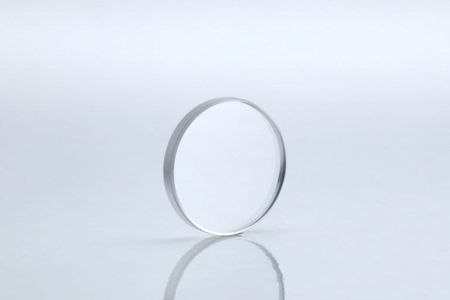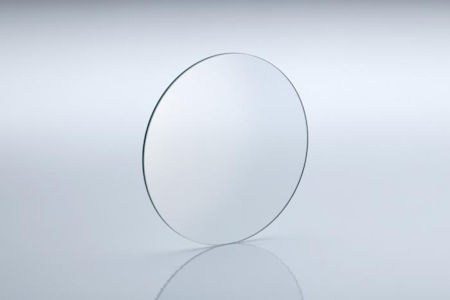In the Spotlight: Calcium Fluoride Optics
15th Dec 2021Here at Knight Optical, we’ve observed a peak in requirement for our custom-made Calcium Fluoride (CaF2) Optical Components. To coincide with this proliferation, we’re placing these in-demand optics under the spotlight. Here, we investigate the substrate’s construction, explore the key features that make it such a sought-after preference and probe deeper into its typical uses.

How is CaF2 Made?
Calcium Fluoride (CaF2) is a crystalline element that is grown by using, what’s known as, the Stockbarger technique, a temperature-operated process that is used to synthesise gemstones, such as crystals1. In the case of our Optics, either naturally-mined or chemically-prepared fluorite is employed to complete the growing process – which is, of course, contingent on the grade in question, which we’ll unearth further below.
The Different Grades of CaF2
Our range is available in three grades and dependent on their end applications, they’re suitable for an extensive array of uses.
These options include:
UV Grade: recognised for its optimal implementation for applications that operate within the ultraviolet (UV) and vacuum ultraviolet (VUV) wavelengths
- IR Grade: also acknowledged as our ‘Standard Grade’ and renowned for its performance within the infrared (IR) region
Raman Grade: best known for its minimal fluorescence with only a singular Raman peak at 321cm.
What are CaF2 Optical Components Used For?
These Optics are exploited for an endless variety of applications, spanning from the visible and UV all the way through to the IR spectrums. For instance, a typical use for our UV-Grade components lies in the form of mirrors for excimer lasers, which are ordinarily found in the lithography industry. However, it’s not just CaF2 that’s popular here – Krypton Fluoride (KrF), Argon Fluoride (ArF) and Magnesium Fluoride (MgF2) mirrors are also commonly brought into play.

Moving right to the other end of the spectrum, our IR-Grade (or Standard-Grade) is often incorporated in thermal imaging devices. This grade of optic is utilised for detectors that require cryogenic cooling, which keeps the detector itself at a consistent, low temperature to reduce thermal noise.
CaF2 Optics: Papers in the News
Now we’ve uncovered a couple of typical uses for CaF2, let’s consider how it’s being applied in some recent research-based projects. These 2021 papers study the chemical compound’s innate characteristics and explain further how it’s applied to real-life applications.
CaF2 Lenses: Ultrafast Laser Microsurgery
Due to its multispectral transparency, CaF2 – alongside Zinc Sulphide (ZnS) – crystals have been brought into an experiment for ultrafast laser microsurgery applications. Here, researchers constructed a diamond-turning device to produce both these compounds into lenses with a surface roughness of 6 and 5nm, respectively, to: “Withstand the high power from ultra-short laser pulses and provide a tightly-focused beam with 1.23μm 1/ e2 spot radius for laser ablation”.2

You can learn more about this project by clicking spiedigitallibrary.org here.
Miniaturised CaF2 Optics: Ultrafast Laser Surgery Probe for Bone Ablation
Our following example again derives from the medical sector, where our leading substrate is rife within much equipment. In this exact biomedical project, investigators worked on an improved ultrafast laser surgery probe using miniaturised CaF2 optics to deliver higher laser peak powers to tissue surfaces3. Comparing the specimen to an alternative that uses ZnS, the results found that by using CaF2, the probe: “Exhibits negligible multiphoton absorption, enabling higher peak power pulse delivery while focusing over a larger ablation field of view (FOV)”.3
Click here to read the full details of this venture.
CaF2 Lenses: Scientific Payloads
While laser applications seem to be the protagonists in the medical field, there’s room for CaF2 Optics overhead, in space, too. In November 2021, researchers investigated the feasibility of reducing the adverse characteristics of using the material at the TOPTEC Centre in the spaceborne FLORIS spectrometer4, which measures vegetation fluorescence from above5. As the paper highlights, crystalline elements, such as CaF2, are regularly drawn on for high-performance space optical systems. It also goes on to mention that this medium is usually specified: “For the wide transmittance range of 350nm to 7μm, high refractive index homogeneity, and low optical dispersion value.”4 One known issue, however, is deformation, which, in this case, researchers conducted to reduce with a specific thermal treatment and some polishing steps.4
Learn more about this paper spiedigitallibrary.org here.

Knight Optical’s CaF2 Optical Component Portfolio
Above are several general and more comprehensive examples of CaF2 in action. At Knight Optical, we offer a variety of these optical components for a diverse range of uses, such as those mentioned above. What’s more, we can work alongside you to produce custom-made variations so, if you’re struggling with the material’s inherent properties on a specific project, we can help you create a bespoke design that slots seamlessly into your application’s discerning demands for optimum implementation.
Our portfolio of CaF2 optics comprises (but is not limited to):
Discover more about what’s on offer from our portfolio and learn further about the substrate by clicking here. As well as custom-made designs, we also offer a choice of CaF2 optical components from stock, which are available for next-day dispatch.
Click here for our range of Calcium Fluoride lenses to view our range of Lenses, and here for our stock Calcium Fluoride Windows.
![]()
Why Choose Knight Optical for your Application?
Discerning customers rely on Knight Optical not only for the premium quality of our output and in-house state-of-the-art Metrology Laboratory and QA Department‘s capabilities but because – as well as a range of Stock Optics (available for next-day dispatch) – we also offer our optics as Custom-Made Components.
This year, we’re celebrating 30 years in business. With three decades’ experience under our belt and a whole host of long-standing world-renowned customers on our books, we are proud to have worked on some of the most ground-breaking innovations.
If you are looking for premium-quality, bespoke optical components, please do not hesitate to get in touch with a member of the Technical Sales Team today.
FOOTNOTES
1https://link.springer.com/referenceworkentry/10.1007%2F978-3-540-72816-0_2926
3https://www.osapublishing.org/boe/fulltext.cfm?uri=boe-12-8-4779&id=453207
5 https://www.mdpi.com/2072-4292/9/7/649